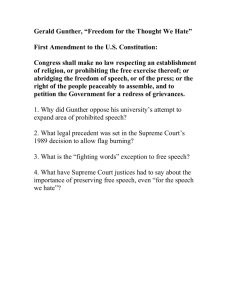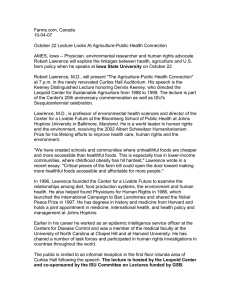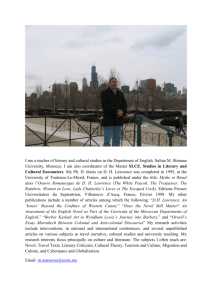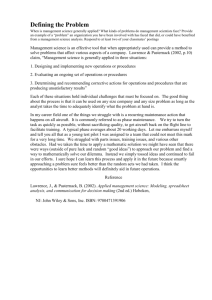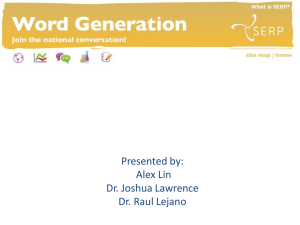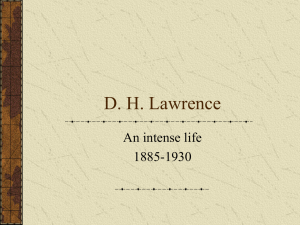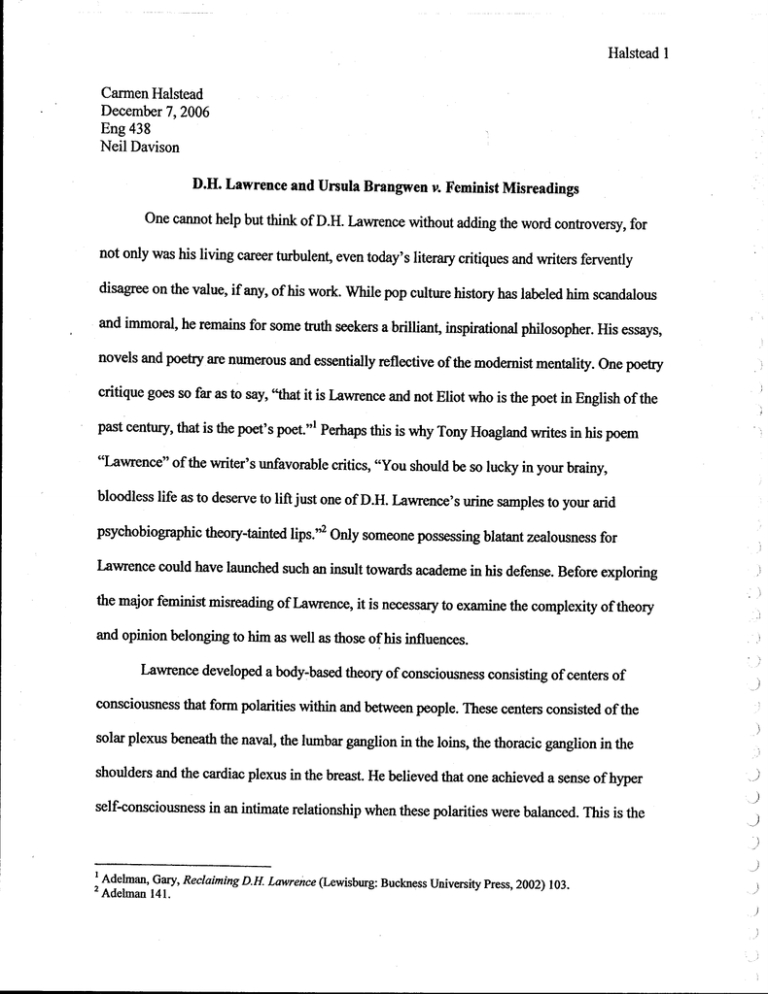
Halstead 1
Carmen Halstead
December 7, 2006
Eng 438
Neil Davison
D.H. Lawrence and Ursula Brangwen v. Feminist Misreadings
One cannot help but think of D.H. Lawrence without adding the word controversy, for
not only was his living career turbulent, even today's literary critiques and writers fervently
disagree on the value, if any, of his work. While pop culture history has labeled him scandalous
and immoral, he remains for some truth seekers a brilliant, inspirational philosopher. His essays,
novels and poetry are numerous and essentially reflective of the modernist mentality. One poetry
critique goes so far as to say, "that it is Lawrence and not Eliot who is the poet in English of the
past century, that is the poet's poet." 1 Perhaps this is why Tony Hoagland writes in his poem
"Lawrence" of the writer's unfavorable critics, "You should be so lucky in your brainy,
bloodless life as to deserve to lift just one of D.H. Lawrence's urine samples to your arid
psychobiographic theory-tainted lips." 2 Only someone possessing blatant zealousness for
Lawrence could have launched such an insult towards academe in his defense. Before exploring
the major feminist misreading of Lawrence, it is necessary to examine the complexity of theory
and opinion belonging to him as well
as those
of his influences.
Lawrence developed a body-based theory of consciousness consisting of centers of
consciousness that form polarities within and between people. These centers consisted of the
solar plexus beneath the naval, the lumbar ganglion in the loins, the thoracic ganglion in the
shoulders and the cardiac plexus in the breast. He believed that one achieved a sense of hyper
self-consciousness in an intimate relationship when these polarities were balanced. This is the
Adelman, Gary, Reclaiming D.H. Lawrence (Lewisburg: Buckness University Press, 2002) 103.
2 Adelman 141.
Halstead 2
fundamental nature of one's transcendental experiences. 3 The goal with this mystical process is
to reach star equilibrium's and spontaneous-creative fullness of being. 5 He states the goal of life is
to perfect the individual. 6 Between two individuals these centers create an eightfold polarity.?
While this theory may be hard for people to accept and believe, it is necessary to
understand before going further into his novels. He felt the novel was the setting in which to
explore his theory and relationships in general. To capture the unconscious emotions that occur
when the centers of two individuals become polarized and react to one another Lawrence used a
mystical/spiritual language to explore this relationship. He states in an essay titled Morality and
the Novel, "No emotion is supreme, or exclusively worth living for. All emotions go to the
achieving of a living relationship between a human being and the other human being or creature
or thing he becomes purely related to." 8 The multitude and complexity of emotions in his work
cannot be overemphasized. It is this focus on the individual and his or her emotions that make
him neo-Romantic, yet the originality of his language and the psychosexual aspects in his work
make him essentially modem.
During the explosion of intellectual thought surrounding the First World War era,
Lawrence found himself swept up in a rapidly changing society, which is reflected in the
underlying, somewhat tumultuous foundation upon which his work rests. Throughout his early
novels, one senses the apocalyptic and anti-technological outlook that is beneath the surface of
his character's relationships. He believed society needed to find the primitive truth in one's
unconscious and placed much emphasized one's need, especially women's for a sexual
3 D.H. Lawrence, Psychoanalyses and the Unconscious (New York: The Viking Press, 1921) 34.
4 D.H. Lawrence, Women in Love. (1920; London: Penguin Books, 1995) 148.
5 Lawrence, Psychoanalyses 48.
6 Lawrence, Psychoanalyses 41.
7 Lawrence, Psychoanalyses 35.
8 D.H. Lawrence, "Morality and the Novel," The Calendar of Modern Letters. 11.10 (1925): 140.
Halstead 3
liberation. He felt the decadence in the modem world was permeated by masculinity and phallic
knowledge,9 which had led to the current state of tumultuous perversion he witnessed in Europe.
As a reaction to the tense political climate of the war, intellectuals took refuge in the individual
and retreated against public life, suppressing political movements, specifically the Women's
Movement. 10 The nature of Lawrence's gender views is largely to blame for the storm of
disagreements surrounding his reputation.
Lawrence felt there was a vital difference between men and women, that "women live
forever by feeling, and men live forever from an inherent sense of purpose . . . each will play at
the other's game, but they will remain apart. "11 This can be deducted from his work, but it is also
further explored in a comical essay Lawrence wrote later in life. In Cocksure Women and
Hensure Men he used an extended metaphor of men and women as cocks and hens in a barnyard
to ridicule women who embrace the old world phallic consciousness, like Gudrun in Women in
Love, by attempting to become men or do the same thing men do in the same manner. Women
like Gudrun have surpassed men in their cocksureness. Instead Lawrence asserts that a woman
should be hensure, meaning possessing outward demureness and inward dauntlessness. He lays
claim that women lack the essential essence to do the cock's job in the same way as men.
Basically, the essay exaggerates his belief that the sexes possess distinctly separate essences, but
also asserts that women should go their own way, find their own individuality, one that
incorporates their essential elements of womanhood instead of trying to copy men, which is a
9 Anne Femhough, introduction. The Rainbow, by D.H. Lawrence (London: Penguin Books, 1995) xxiv.
Femhough xxi.
11 D.H. Lawrence, Fantasia of the Unconscious (New York: The Viking Press, 1921) 137.
Halstead 4
denial of their womanhood. 12 While this belief seems constant throughout his work, his ideas on
feminism seemed to waver, especially in the early novels.
Critical interpretations are varied and contradictory regarding the way women and their
rights are interwoven through Lawrence's work. Anne Fernhough attributes this inconsistency to
his oscillating opinions on feminism during the time period The Rainbow and Women in Love
were composed. 13 While the first novel in his major work traces the change in women's
education and Ursula's development, I4 the second novel emphasizes the heroine in a state of self
awareness that accepts what Lawrence felt was the true liberation for women and a rejects the
Women's Movement, which he felt was tainted by capitalism and industry. 15 This rejection is in
large part to blame for the reputation that Lawrence accrued as a misogynistic and sexist writer.
The most notable feminist critical interpretations of Lawrence's women is Kate Millett's Sexual
Politics.
In this landmark study she states, "Lawrence is the most talented and fervid of sexual
politicians. He is the most subtle as well, for it is through feminine consciousness that his
masculine message is conveyed ... It is no wonder Simone de Beauvoir shrewdly observed that
Lawrence spent his life writing guidebooks for women." 16 Later feminist critiques such as Hilary
Simpson acknowledge that Lawrence was still operating under attractions to the Women's
Movement while writing his early work, but in his later work adopts a "rigid and deterministic
sexual hierarchy." 17 Simpson's response to Women in Love is "that Lawrence has no one axe to
grind; in a complex presentation of possibilities and potentialities we are not forced to take
12 D.H. Lawrence "Cocksure Women and Hensure Men" Sex, Literature and Censorship ed. Harry T. Moore (New
York: Twayne Publishers, 1953) 47-50.
13 Fernhough xvi.
14 Peter Preston, Peter Hoare, D.H. Lawrence in the Modern World "The Sense of History in 'The Rainbow.'
(Cambridge: Cambridge UP, 1989) 127.
5 Femhough xix.
16 Kate Millett, Sexual Politics 1969 (London: Rupert Hart-Davis, 1971) 239.
17 Hilary Simpson, D.H. Lawrence and Feminism (Dekalb: Northern Illinois University Press, 1982) 17.
Halstead 5
sides."18 Unlike Simpson though, Millett seems to have an axe to grind against Lawrence, in
particular against Ursula for turning her back on the Women's Movement in The Rainbow. She
analyzes Women in Love to explain how Lawrence demeans his female characters and asserts
masculine dominance. She claims Lawrence develops "powerful feelings of hostility and a
negative attitude toward women," 19 and goes on to say that he reduces Ursula to nothing more
than "Birkin's wife and echo."2° This absurd accusation misses what Lawrence attempted to
explore through Women in Love with their relationship. My purpose here is to defend
Lawrence's Ursula against such a misconstrued interpretation and assert, through Women in
Love, that Lawrence puts her in a favorable light as a strong individual woman.
In the chapter Mino, Lawrence uses Birkin as a mouthpiece to introduce the author's
theory regarding the ideal relationship and the concept of star equilibrium to Ursula and the
reader. In their conversation over tea, Birkin is trying to work out his thoughts on what he wants
from Ursula, in the process he contradicts himself and enrages her. Birkin insists that he has no
emotions towards her, and doesn't want her "womanly feelings," while Ursula is adamant that he
must acknowledge he loves her. She makes fun of what she perceives as his absurdity and
becomes angered when Birkin teasingly uses the cat to affirm male superiority. The argument
finally comes to a head with Ursula's response to Birkin's recurring simile likening his ideal
relationship to two balanced stars:
"I don't trust you when you bring in the stars," she said. "If you were quite true, it
wouldn't be necessary to be so far-fetched."
"Don't trust me then," he said, angry. "It is enough that I trust myself."
"And that is where you make another mistake," she replied. "You don't trust
yourself. You don't fully believe yourself what you are saying. You don't really want this
conjunction, otherwise you wouldn't talk so much about it, you'd get it."
Is Simpson 65.
19 Millett 257.
20 Millett 263.
Halstead 6
He was suspended for a moment, arrested.
"How?" he said.
"By just loving," she retorted in defiance.21
This scene demonstrates the way Lawrence uses Ursula to ground Birkin's ideas and call
him on his hypocrisy. She refers to his relationship with Hermione, defiantly accusing him of not
really wanting a balanced relationship because he is still attached to an obviously imbalanced
relationship that is not giving him what he wants. Also, she points out that his theory is too far
based within the mind; he needs to recognize that emotions are partly what will get him to the
mystical beyond. If this is what he truly wants, he will have to acknowledge his love for her,
which he ends up doing by the end of the chapter. It is the unconscious emotions that occur
between two people, which polarize to create true intimacy, not the many words Birkin uses in
an attempt to achieve this. Lawrence's theory of star equilibrium can only be achieved in a place
where there is no talking; there is only feeling. Ursula brings this aspect to the relationship in a
way that reconciles Lawrence's gender beliefs in that she is essentially operating from the female
essence of feeling. However, she is in no way viewed in a negative light. If anything, she comes
out of this argument with the upper hand, making Birkin look like a rambling fool.
Millett's analysis of this chapter is a prime example of a feminist misreading. She says
that Birkin's proposal denies Ursula's personality and is "posing as an affirmation of the primal
unconscious sexual being." She goes on to say, "Birkin is full of opinions and ideas and holds
forth all through the book while Ursula puts docile leading questions to him. Though she requires
some effort to tame she comes to follow him in apostolic faith."22 Birkin is still trying to perfect
his theory with language and doing a poor job of articulating it to Ursula in Mino. While one can
consent to his proposal being a denial of her personality, the idea and theory he is attempting to
21 Lawrence, Women in Love 150-152.
22 Millett 264.
Halstead 7
explain does not deny the woman's personality. It is indeed her individuality that is needed for
the relationship to reach the beyond he speaks of. This is evident with the way Mino unfolds;
Ursula ends up teaching Birkin that her personality and female nature is necessary, and until he
can accept that, he will not reach the darkness he wishes to enter. Ursula does not do this with
"docile" questions; she is an intelligent and highly perceptive woman. She realizes right away
when Birkin is contradicting himself and passionately tells him as much. Up until the last page of
the novel, Ursula argues with her husband and refuses to accept some of his notions. Calling her
docile and a tame apostle does her an injustice.
Millett's analysis can be juxtaposed against Peter Balbert's in D.H. Lawrence and the
Phallic Imagination. He writes:
My point is not that Birkin's contradictory attitudes and fluctuating views of the world
are surprising or debilitating. It is that Ursula listens to him with the keen interest of an
alert and serious suitor, and her skeptical responses to his proposals are not to be
dismissed as her inability to comprehend radical notions, which some condescending
criticism about Ursula suggests. Ursula does have a substantive quarrel with his theories
because of her more spontaneous approach to life.23
Their quarrel is rightly attributed to their difference in nature. Birkin as a male is driven by a
sense of purpose, which is why he is often likened to a teacher. Ursula is sensitive and
emotionally responsive to her surroundings. In this way they possess the vital natures Lawrence
saw differentiating the sexes. Ursula listens to him over tea attempting to decide if he has what
she feels is missing from life that her other suitors and past partners could not give her. One
should not be surprised at the change in Birkin's views throughout Women in Love. He is
responding to Ursula and as they come to know each other, she forces him to reconsider aspects
of his life that he otherwise would not have, in the same way he introduces her to philosophies
she has not considered. Throughout the entire Mino scene, Ursula comes across as witty and
23 Peter Balbert, D.H. Lawrence and the Phallic Imagination (New York: St.Martin's Press, 1989) 95.
Halstead 8
independent. With Gudrun, she acquiesces even when she is not in accord with her sister's
opinions,24 but with Birkin she is moved to argue and try to understand him. This response is
specifically derived from Birkin and is an aspect of their relationship not lost after marriage. It
therefore could be argued that the pursuit of star equilibrium, rather than denying Ursula's
personality, is aiding in the enhancement of her individuality.
Mooney provides an example of the polarized push and pull between people mentioned in
Lawrence's theory of consciousness. In the argument that ensues Birkin's attempt to smash the
moon, Ursula calls him egocentric. She goes on to say:
"You want me to be your thing, never to criticize you or to have anything to say
for myself. You want me to be a mere thing for you! No thank you! If you want that,
there are plenty of women who will give it to you. There are plenty of women who will
lie down for you to walk over them-go to them then, if that's what you want-go to them."
"No," he said with outspoken anger. "I want you to drop your assertive will, your
frightened apprehensive self-insistence, that is what I want.-I want you to trust yourself
so implicitly, that you can let yourself go."
"Let myself go!" She re-echoed in mockery. "I can let myself go, it is you who
hang on to yourself as if it were your only treasure. You-you are the Sunday school
teacher-you-you preacher."
The amount of truth that was in this made him stiff and unheeding of her.25
This argument is almost comical, each person is so determined to escape the domination they
believe the other wants to exert, that they repel against each other, like magnets of the same
charge. Ursula is misunderstanding what Birkin wants from her. She is reacting against her
notions of submission and dominance inherited from the old world of phallic knowledge. The
idea mentioned here of the will, as something one needs to let go of, can be seen as a return to
primitivism. Lawrence believed one's will was for "exerting a certain control over the vital and
automatic processes of his own evolution." 26 When one loses their will, they allow their mind to
relinquish control to the unconscious, so the polarization is not disturbed by the mind and can
24 Lawrence, Women in Love 21.
25
Lawrence, Women in Love 250.
26 Lawrence, Psychoanalysis 47.
Halstead 9
lead the individual into the great beyond. In this scene, both Ursula and Birkin are so devoted to
perfecting their own individual self, that they often cannot see their own faults, especially Birkin.
In Mooney she points out to him, as she did in Mino, that he is a hypocrite and once again, he
realizes her correctness. Lawrence using Ursula in this way to ground Birkin, the often-wordy
philosopher, develops into a pattern throughout the novel.
In Woman to Woman, during her conversation with Hermione, Ursula contemplates the
consequences of furthering her relationship with Birkin. Since she is an independent woman and
knows from past experiences what she does not want from a man, this decision to surrender to
Birkin as more than a mistress or lover is fraught with consequences, which she must work out
on her own, before she submits to him. She ponders his contradictions and what he wants from
her, "He did not want an odalisk. He wanted a woman to take something from him, to give
herself up so much that she could take the last realities of him . . . And if she did, would he
acknowledge her . . . or would he use her just as an instrument . . . That was what the other men
had done."27 Ursula begins to realize here that the submission Birkin wants from her is not one
that allows him to take complete control over her body, mind and spirit, as her past lovers had. It
is an equal submission between the two of them; she is taking from him as well. In his beyond
they both let go of themselves, rather than one member of the union taking control from the
other. She reveals some doubts about what this will do to her individuality; this demonstrates the
importance she places on maintaining the independence she has worked so hard to gain, as well
as the level of self-awareness she possesses. In the past, she has had a dominant relationship
similar to Gerald and Gudrun's, this type of connection is a superficial one in which the self is
lost. For Millen to read the submission Ursula gives to Birkin as one of masculine dominance is
to misunderstand the language and attach meanings to it that Lawrence did not implicate.
27 Lawrence, Women in Love 295.
Halstead 10
Further on in the women's conversation, Ursula realizes that Hermione wants a
masculine man not a sensitive one like Birkin.28 The women here are purposely presented as
opposites, Hermione still attached to the traditional view of love, in which the female gladly
yields complete control to the male. Millett accuses Lawrence of campaigning in opposition of
the modern woman through Hermione's character. She claims, "The portrait of Hermione is
probably the most savage personal attack Lawrence ever wrote. 29 She is the new woman as
intellectual, a creature to whom both Birkin and the narrator react with almost hysterical
hatred."3° Lawrence's attack on Hermione in Women in Love, serves the greater purpose of
alienating Ursula from any kind of social movement to advance her own individuality. To claim
that Birkin reacts to her with hysterical hatred is an exaggeration. If anything it is the other way
around, after all she is the one who hits him on the head with a jewel stone 31 If his reaction, to
walk into the woods and reflect on the issue, then compose a letter telling the woman she was
"quite right to biff" hhn, 32 is what Millet considers hysterical, how much credit can we give the
rest of her argument?
In Snow we see the effect of Ursula's relationship with Birkin on her relationship with
Gudrun. Millet claims that "Women in Love presents us with the new man arrived in time to give
Ursula her comeuppance and demote her back to wifely subjection." 33 The scene in which
Gudrun states that love is the supreme emotion and Ursula argues with her reveals how Ursula
has grown as an individual. This is a benchmark to demonstrate how much more confident in her
beliefs she is at the end of the novel compared to the beginning, when she easily acquiesces to
28 Lawrence, Women in Love 297.
29 Actually, I think he wrote a more savage attack towards his parents, but I will allow Millett this opinion.
38 Millett 263.
31 Lawrence, Women in Love 105.
32 Lawrence, Women in Love 108.
33 Millett 262.
Halstead 11
her sister. Ursula responds to Gudrun's statement with an explanation of what she now believes
in after experiencing star equilibrium with Birkin. She thinks, "Because you never have loved,
you can't get beyond it." 34 She is reflecting here on her own state of being before reaching star
equilibrium, when she was in accord with her sister. This realization is essential for its simply
statement account of the central relationship's development and why it is not occurring with
Gerald and Gudrun. Basically once both Ursula and Birkin, who had already gone through the
process of becoming strong individuals, allowed themselves to experience the emotion of love,
they were able to let themselves go and surrender to this love, from which resulted an altered
state of consciousness. The end of Women in Love leaves the reader with a fictional example of
what Lawrence saw as the heart of life, an ideal relationship. However, it purposely ends with a
disagreement about his desire for homosocial connections elsewhere. Ursula's last words in the
novel are an argument; therefore she leaves the reader with a strong sense of independence from
her husband, and not a sense the she is in a state of "wifely subjugation" as Millett would have us
believe.
Her Sexual Politics argument, which spurred Lawrence's negative reputation regarding
women, is a misinterpretation of his work. She read him with a preconception of his supposed
gender bias, which is a bias in itself. If one looks to Lawrence's work in the hopes of finding
minute details to support an inflated argument, one will find them. However, if one comes to the
work with an open mind and takes each character as they are presented, instead of how they can
be interpreted and molded to fit a political agenda, one will fmd a complex Lawrence that is
appreciative of women and interested in advancing both women and men towards a liberation of
the soul.
34 Lawrence, Women in Love 438.
Halstead 12
Works Cited
Adelman, Gary. Reclaiming D.H. Lawrence. Lewisburg: Bucknell University Press, 2002.
Balbert, Peter. D.H. Lawrence and the Phallic Imagination. New York: St. Martin's Press, 1989.
Fernhough, Anne. Introduction. The Rainbow. 1915. By D.H. Lawrence. Ed. Mark KinkeadWeekes. London: Penguin Books, 1995.
Lawrence, D.H. Women in Love. 1920. London: Penguin Books, 1995.
---. Psychoanalysis and the Unconscious. New York: The Viking Press, 1921. (course reserve).
---. Fantasia of the Unconscious. New York: The Viking Press, 1921. (course reserve).
--. "Cocksure Women and Hensure Men." 1928. Ed. Harry T. Moore. Sex, Literature and
Censorship. 1928. New York: Twain Publishers, 1953. 47-50.
---. "Morality and the Novel." The Calendar of Modern Letters. 11.10 (December 1925). 269-74.
(course reserve).
---. "Why the Novel Matters'. Phoenix. 1936. (course reserve).
Millett, Kate. Sexual Politics. 1969. London: Rupert Hart-Davis, 1971.
Simpson, Hilary. D.H. Lawrence and Feminism. Dekalb: Northern Illinois University Press.
1982.

